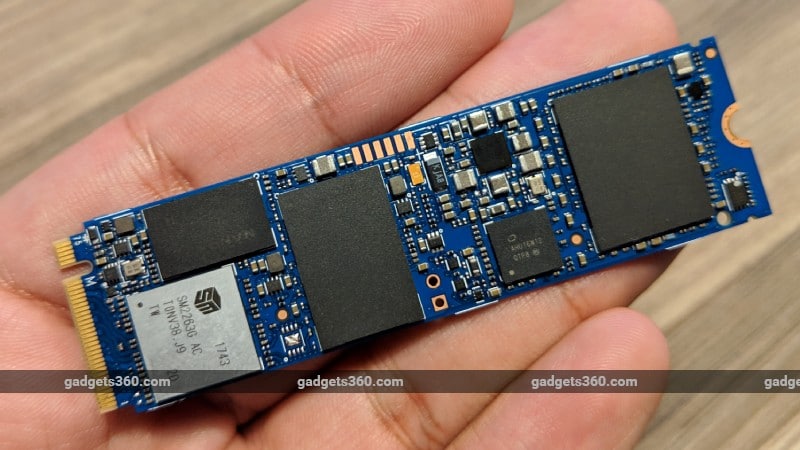- Home
- Laptops
- Laptops News
- Intel’s New Optane Memory H10 SSD Uses Optane With QLC Flash for Speed and Capacity
Intel’s New Optane Memory H10 SSD Uses Optane With QLC Flash for Speed and Capacity

Intel has announced its new hybrid Optane Memory H10 SSD, which offers both Intel Optane Memory as well as QLC Flash storage on a single M.2 module. The unit is designed specifically for laptops with only a single M.2 slot, which have not been able to take advantage of a discrete Intel Optane Memory module before now. According to Intel, this has been developed in response to demand from laptop manufacturers. Just like any other combination of an Optane Memory module and storage device, the user of a PC will see only a single virtual storage volume, which is managed by the Intel Rapid Storage Technology driver.
While the QLC flash will serve as the primary storage space, the smaller Optane Memory chip will allow for accelerated reads and writes. Intel's software prioritises operating system files and learns what else a user accesses frequently, and caches as much as possible on the Optane Memory media. You can read all about what makes QLC Flash interesting in our review of the Samsung SSD 860 QVO.
The Optane Memory H10 SSD is not yet ready to ship, and Intel has not disclosed any performance figures. The company is calling this a technology announcement on the sidelines of CES 2019, not a product announcement. It is expected to launch in laptops from multiple major brands by the second quarter of this year, and plans for retail availability are not yet decided.
Three different capacity options will be available: 16GB + 256GB, 32GB + 512GB, and 32GB + 1TB, with the smaller figures referring to Optane Memory and the larger ones referring to QLC Flash. Intel says the QLC being used is the same as what's in the previously announced Intel SSD 660p. This should not be confused with Intel's Optane SSD drives, which use Intel's super-fast Optane media for storage.
Although the two physical components and their respective controllers and circuitry live on the same M.2 module, they do not interact directly. Each one has access to two PCIe lanes, which could have some impact on general performance. It remains to be seen how the Optane Memory H10 SSD stacks up against a standard SSD in terms of cost and performance.
Laptop manufacturers will be able to claim improved responsiveness as well as quicker boots and resumes from standby, now with their thin and light models. The use of QLC flash in particular is likely to reduce overall cost while allowing for up to 1TB of capacity on a standard single-sided M.2 2280 module.
Intel also made a number of big announcements at its CES 2019 press conference, including the upcoming 'Ice Lake' 10nm CPU series, a new 'Lakefield' hybrid CPU with heterogenous cores, and the Project Athena programme for a new generation of connected laptops.
Disclosure: Intel sponsored the correspondent's flights and hotel for the trip to CES, Las Vegas.
8K TVs, insane soundbars, folding phones, modular laptops: Who won CES 2019? We discussed this on Orbital, our weekly technology podcast, which you can subscribe to via Apple Podcasts or RSS, download the episode, or just hit the play button below.
For the latest tech news and reviews, follow Gadgets 360 on X, Facebook, WhatsApp, Threads and Google News. For the latest videos on gadgets and tech, subscribe to our YouTube channel. If you want to know everything about top influencers, follow our in-house Who'sThat360 on Instagram and YouTube.
Related Stories
- Samsung Galaxy Unpacked 2025
- ChatGPT
- Redmi Note 14 Pro+
- iPhone 16
- Apple Vision Pro
- Oneplus 12
- OnePlus Nord CE 3 Lite 5G
- iPhone 13
- Xiaomi 14 Pro
- Oppo Find N3
- Tecno Spark Go (2023)
- Realme V30
- Best Phones Under 25000
- Samsung Galaxy S24 Series
- Cryptocurrency
- iQoo 12
- Samsung Galaxy S24 Ultra
- Giottus
- Samsung Galaxy Z Flip 5
- Apple 'Scary Fast'
- Housefull 5
- GoPro Hero 12 Black Review
- Invincible Season 2
- JioGlass
- HD Ready TV
- Laptop Under 50000
- Smartwatch Under 10000
- Latest Mobile Phones
- Compare Phones
- Vivo X200 Ultra
- Vivo X200s
- Oppo K13 5G
- Infinix Note 50s 5G+
- Itel A95 5G
- Samsung Galaxy M56 5G
- HMD 150 Music
- HMD 130 Music
- Asus ExpertBook P3 (P3405)
- Asus ExpertBook P1 (P1403)
- Moto Pad 60 Pro
- Samsung Galaxy Tab Active 5 Pro
- Redmi Watch Move
- Oppo Watch X2 Mini
- Xiaomi X Pro QLED 2025 (43-Inch)
- Xiaomi X Pro QLED 2025 (55-Inch)
- Nintendo Switch 2
- Sony PlayStation 5 Pro
- Toshiba 1.8 Ton 5 Star Inverter Split AC (RAS-24TKCV5G-INZ / RAS-24TACV5G-INZ)
- Toshiba 1.5 Ton 5 Star Inverter Split AC (RAS-18PKCV2G-IN / RAS-18PACV2G-IN)















